The US is home to a variety of terrestrial, aquatic, and semi-aquatic turtles. However, the species are not distributed evenly in all 50 states. Some have more than 20 species of turtles, while others have very few native turtles. The state of Ohio happens to be one of those states with a variety of turtle species.
How many turtle species are in Ohio?
There are 12 native turtle species in Ohio. Below is a list of all the native turtles in Ohio:
- Midland Painted turtle
- Common map
- Common musk
- Blanding’s turtle
- Common snapping
- Eastern spiny softshell
- Eastern box
- Midland Smooth Softshell
- Ouachita map
- Red-eared slider
- Spotted turtle
- Wood turtle
Some of these species are pretty similar in terms of their features and behavior, while others are quite distinct. Below, we will explore the different species of turtles in Ohio, their features, characteristics, and conservation status.
Midland Painted Turtle
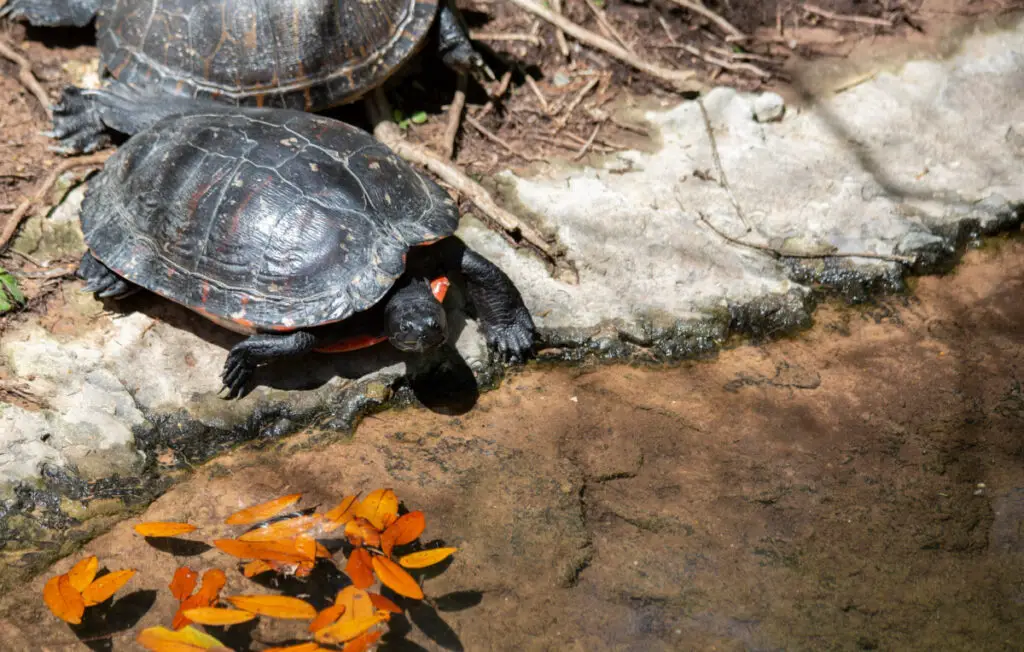
Midland-painted turtle is one of the most common native turtles in Ohio. Its scientific name is Chrysemys picta marginata. They are colored, both on the skin and the shells, and are mostly either black or dark brown. On the edges, the shells have a shade of either orange or red.
Midland turtles also have either red or yellow markings on their shells. Their carapace length measures between 4.5 and 5.5 inches.
They have long red or yellow stripes running from their heads to the neck. A distinguishing feature of the male Midland turtles is that they have elongated claws on their forelimbs.
While there are other painted turtle species worldwide, the Midland painted turtle is the only one found in Ohio.
Midland painted turtles are omnivorous, and their diet mainly consists of fruits, vegetables, aquatic vegetation, small aquatic animals and fishes, and some invertebrates. Nesting in these turtles takes place between March and June. The incubation period for Midland turtles is around 80 days. A female will lay a minimum of four and a maximum of ten eggs per clutch.
Males take between 2-9 years to mature, while females take up to 16 years. They live for an average of thirty-five years. A juvenile painted turtle costs between $20 and $50 and is pretty easy to take care of as a pet.
Common Map Turtle
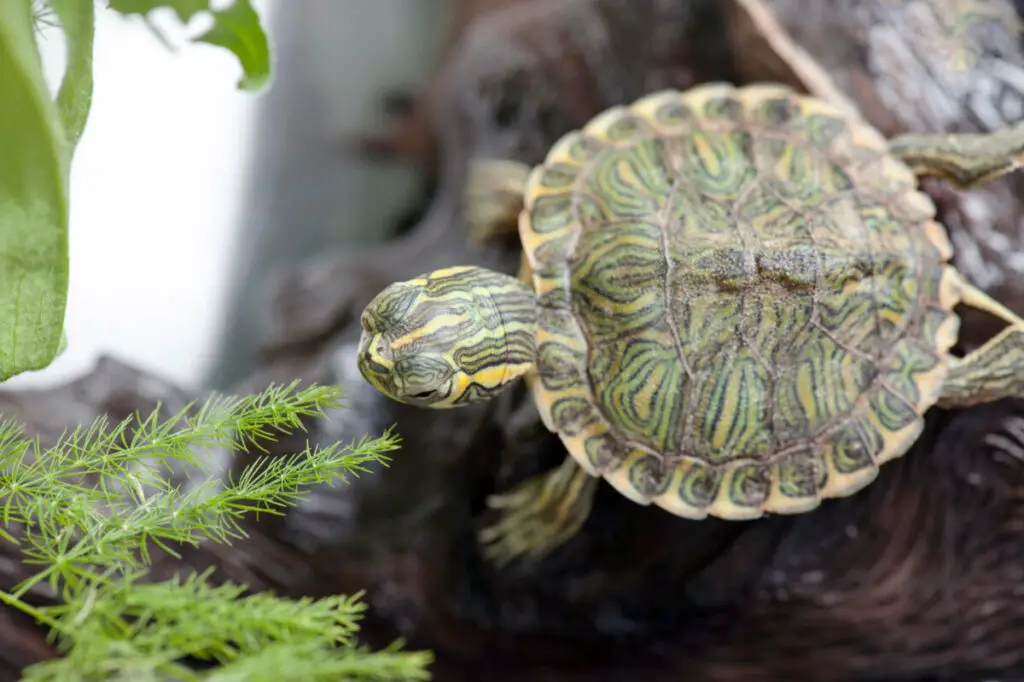
Their scientific name is Graptemys geographica. They are named after the map-like patterns on their carapace. The carapace has an olive green color and is keeled with rough edges towards the rear.
Common map turtles have complex and intricate thin yellow striped patterns on the head, neck, and limbs. A distinctive feature is the bright yellow and sometimes orange spots behind each eye. Their plastron has a cream color with dark lines that disappear as the turtle ages.
Female map turtles are known to grow bigger than males. A mature female may mature to 11 inches’ length while males only achieve a meager 5 inches. As aquatic turtles, they are common in water bodies with slow-moving, shallow waters with a soft bottom. They also prefer open areas where they can enjoy basking on the rocks.
They are omnivorous and mainly feed on aquatic vegetation, small marine animals, invertebrates, and mollusks. Their lifespan ranges between 40 and 50 years. Males and females achieve sexual maturity by the 6th and 10th years, respectively.
Common map turtles breed from May through July. A female will lay between 10-12 eggs per clutch and will sometimes lay up to 2 clutches every year. Incubation lasts between 70 and 90 days. They do not require much as pets, and a hatchling will cost between $30 and $50. They are also not an endangered species.
Common Musk Turtle
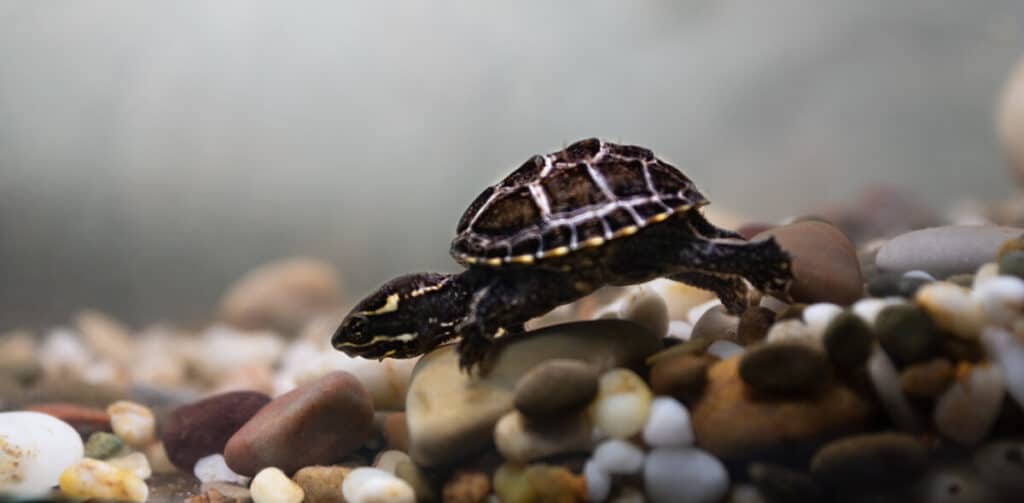
Their scientific name is Sternotherus odoratus, and they are plain turtles with consistent colors. A common musk turtle’s shell is black or brown, with a ridge that runs across the entire length.
These turtle species have two distinct light-colored stripes that run from their head to the neck. They are usually small, only reaching sizes of between 3 and 4.5 inches in length.
These turtles are common in either still or slow-moving aquatic bodies with soft bottoms. They usually burrow under this soft mud when hibernating in winter. Common map turtles are generally omnivorous, and their diet comprises fruits, seeds, aquatic vegetation, tadpoles, small fishes, and aquatic insects.
When it comes to breeding, a female musk turtle lays her eggs between May and July. She may lay up to 9 eggs in a clutch and up to two clutches every year. Incubation takes between 75 and 90 days, from July to September. Females mature after four years, while males take about three years.
Common map turtles are also known as “stinkpots,” owing to the strong odor they produce when threatened as a repellant to their predators.
In terms of conservation status, they are not considered as endangered. Their lifespan is between 30 and 50 years. As a pet, they can be pretty aggressive and hence require some large clean tank. A juvenile common map goes for about $30.
Blanding’s Turtle
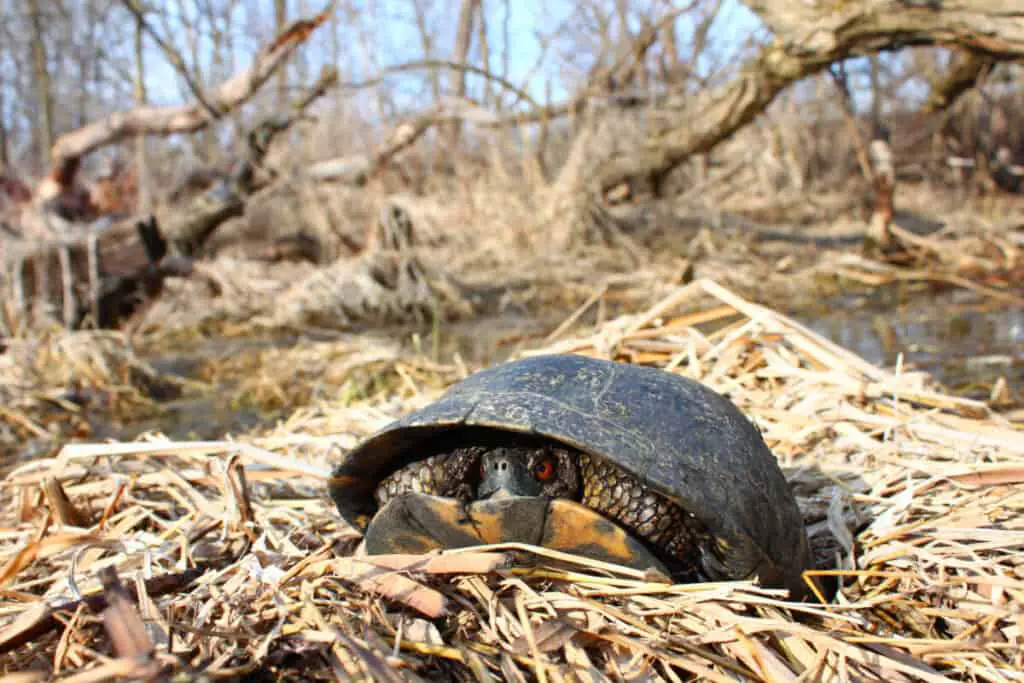
The scientific name of this aquatic turtle is Emydoidea blandingii. One of the most distinctive features about it is its dome-shaped shell that is more prominent than in most turtles. Its carapace has a dark brown or black color.
Blanding’s turtle’s plastron has a yellow color with some black patches. The neck is yellow, while the limbs are black. Their feet are webbed, which means that a Blanding’s turtle is an excellent swimmer.
This turtle achieves a length of between 7-9 inches when mature. In Ohio, the Blanding’s turtle is mainly found in slow-moving or still water bodies like poorly drained areas, ponds, and small rivers.
As omnivorous, it feeds on a variety of small animals like mollusks, crustaceans, insects, and a variety of plants and aquatic vegetation. Their primary hunting tactic is by lying still and attacking prey when they are at a striking distance.
Sexual maturity in Blanding’s turtle occurs by the 12th year in males, while in females, it occurs by the 18th year.
A female will lay about 6-15 eggs in each clutch and up to two clutches in a year. Breeding occurs between May and September. Incubation takes between 70 and 90 days. The main threats during incubation are skunks and raccoons that love feeding on the eggs and hatchlings.
In terms of their conservation status, Blanding’s turtles are considered endangered in Ohio due to habitat destruction and increased predation threat. For those that would love to keep a Blanding turtle pet, it will cost you about $300 to acquire a hatchling.
Common Snapping Turtle
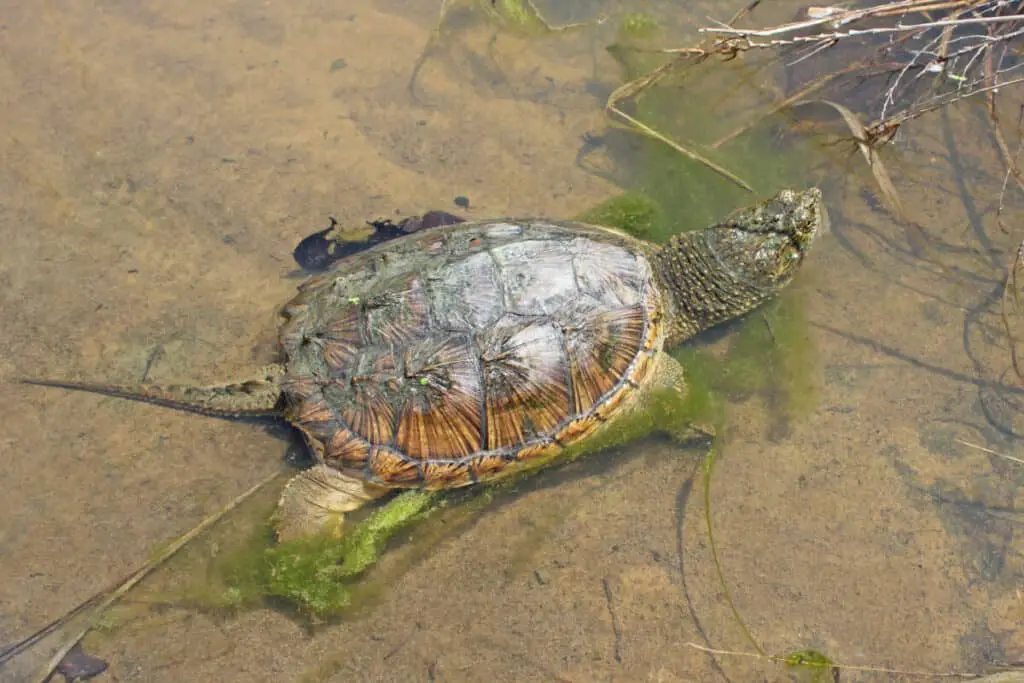
A common snapping turtle is another turtle native to Ohio. They usually have rugged and ridged shells. This turtle species also has wart-like projections on their limbs and neck. In addition, they have a long and rough tail, unlike most species. The carapace is tan, brown, or sometimes black.
Their neck a slightly longer than most turtles and has a nodding behavior when they walk. They are known to be an aggressive type and thus require a lot of space. They have a strong jaw and beak-like, which can cause severe damage when it bites.
Common snapping turtles are aquatic and highly mobile in water. They inhabit slow-moving freshwater bodies like rivers, lakes, and ponds. When startled, they dive to the bottom and burrow themselves under the mud. They are rarely out of the water and rely majorly on aquatic food. Being omnivores, their diet composes of crustaceans, small fish, tadpoles, and aquatic vegetation.
Sexual maturity in females in these snapping turtles is achieved by the 15th year. In captivity, their lifespan can extend to 40 years. However, there are records where they have survived even for 100 years.
Mating and nesting happen between April and July. A female will lay one clutch per year containing up to 40 eggs. Incubation takes between 90 and 100 days. The main predator during incubation is the raccoon that feeds on both the eggs and hatchlings.
For one to own a hatchling, they will need some experience in the past of handling turtles. This is due to their aggressive nature. You should also ensure to have ample space for the turtle in the form of a big clean tank. A baby snapping turtle in Ohio costs between $30 and $40.
Eastern Spiny Softshell Turtle
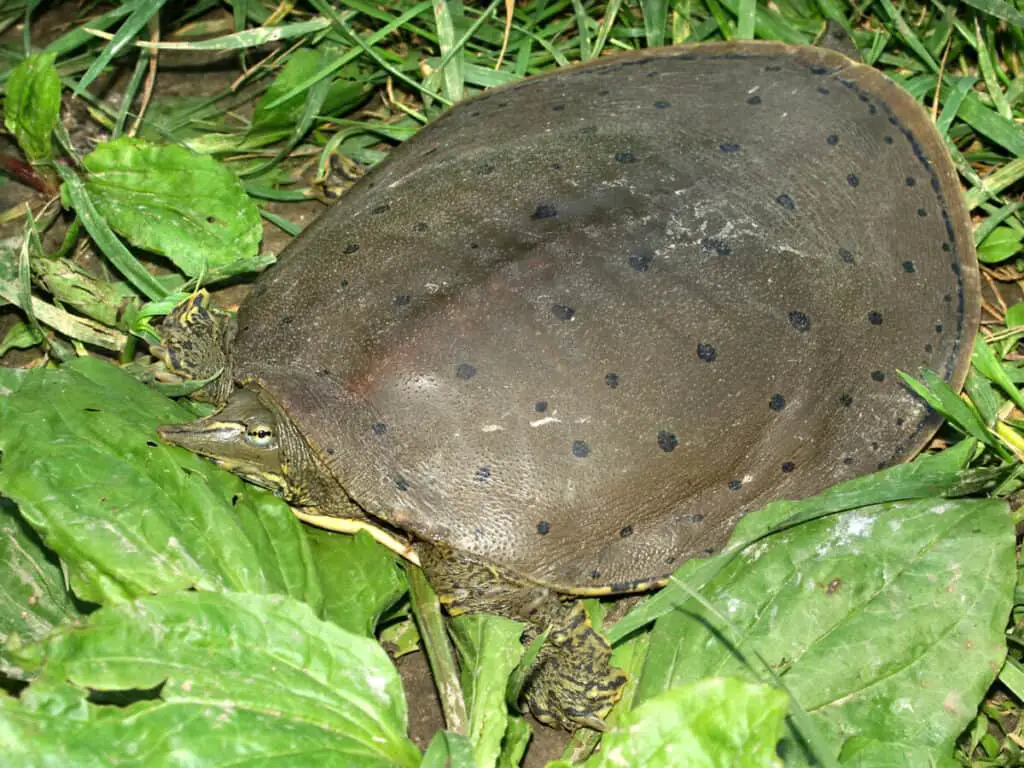
Unlike most turtles, an Eastern spiny softshell turtle has a soft, smooth, leather-like, and flattened round shell. They are scientifically named Apalone spinifera.
The color of their shell ranges from olive-grey to yellowish-brown. This turtle has round spots on the shell that are more conspicuous in adults than in younger ones. In addition, their mouths have an extended beak-like snout.
A mature male spiny turtle can grow up to between 5 and 9 inches in length. Females, in comparison, grow bigger, attaining up to 12 to 20 inches in length. Being aquatic, these turtles spend most of their lives in shallow and slow-moving water bodies with soft bottoms. They are usually found in ponds, rivers, and lakes with little vegetation. These turtles will bury their bodies in the water, leaving only the heads exposed when threatened.
Spiny softshell turtles are considered carnivorous in nature, with their diet comprising small fish, insects, aquatic invertebrates, and other small aquatic animals. They have webbed feet, which makes them well-adapted to swimming. This aids them greatly when hunting for prey.
Breeding in eastern spiny softshell turtles happens between May and July. Females achieve sexual maturity by the 10th year, while in males, it takes about six years. A Females spiny softshell turtle will lay between 4 and 38 eggs in each clutch. It takes between 60 and 80 days for the eggs to hatch. Their lifespan is about 50 years.
An Eastern spiny softshell turtle hatchling will cost between $80 and $140. You will need to have prior turtle skills in order to take care of this species. Their primary risks are the destruction of their habitat and, in some places, invasion by other turtle species.
Eastern Box Turtle
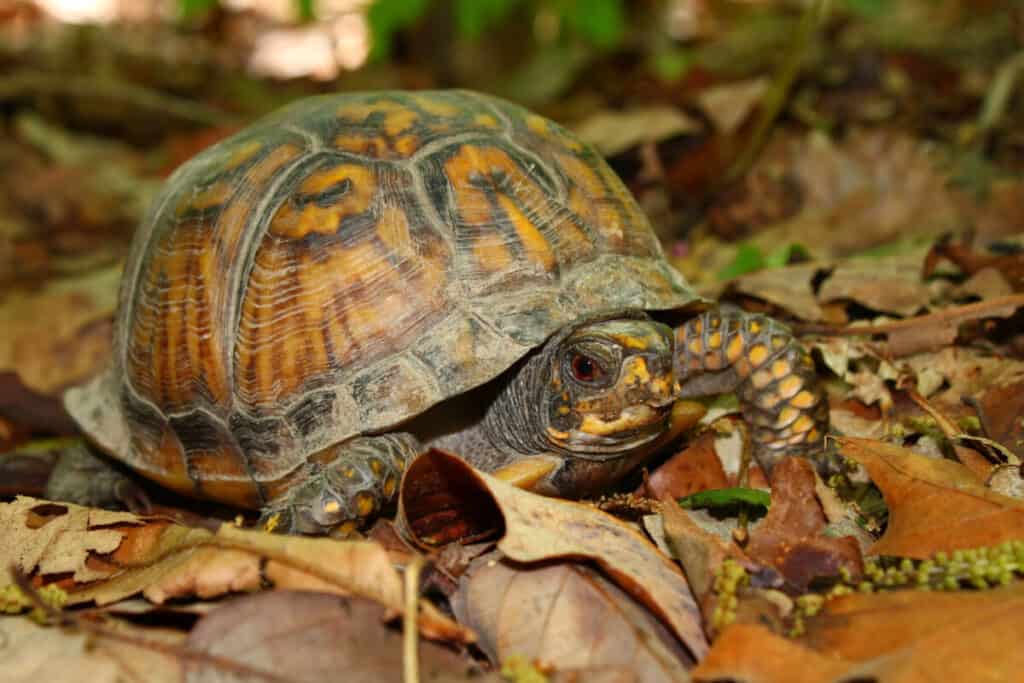
The scientific name for these turtles is Terrapene Carolina Carolina. They have a dome-shaped brown or black carapace with some yellow markings. Eastern box turtle’s skin and neck resemble the shell, but they have large blobs that range from red to orange. An exciting feature is that they have the ability to heal their shell from injuries.
Although they are majorly aquatic, it is not unusual to find them roaming on land searching for food. You may also find them in open grassland with lots of dead vegetation. They may walk up to 50 meters daily. However, Eastern box turtles don’t venture very far away from their habitats. They are common in well-shaded water bodies like ponds and streams.
Eastern box turtles are omnivores with a large appetite feeding on almost any type of food that comes their way. Their primary food source includes grubs, slugs, earthworms, grass, beetles, caterpillars, snails, weeds, fruits seeds, and mushrooms.
Further, there are records of them attacking downed birds.
Eastern box turtles are usually tiny turtles, only achieving about 6 inches in length when mature. A female may take up to 10 years to achieve maturity, while a male turtle will take about five years. They have a long lifespan of between 60 and 100 years.
Breeding happens between May and July. Female turtles will lay about 3 to 6 eggs in a clutch. They lay between one and two clutches in a year. If the conditions are not favorable, a female turtle may store up sperms in her body, awaiting better laying conditions, and is able to hold viable sperms for up to 4 years.
Eastern box turtles are low maintenance for pet owners, and they require little skills to take care of. A person with no experience can take care of one by following the given guidelines. On average, a hatchling box turtle costs between $150 and $400.
Midland Smooth Softshell
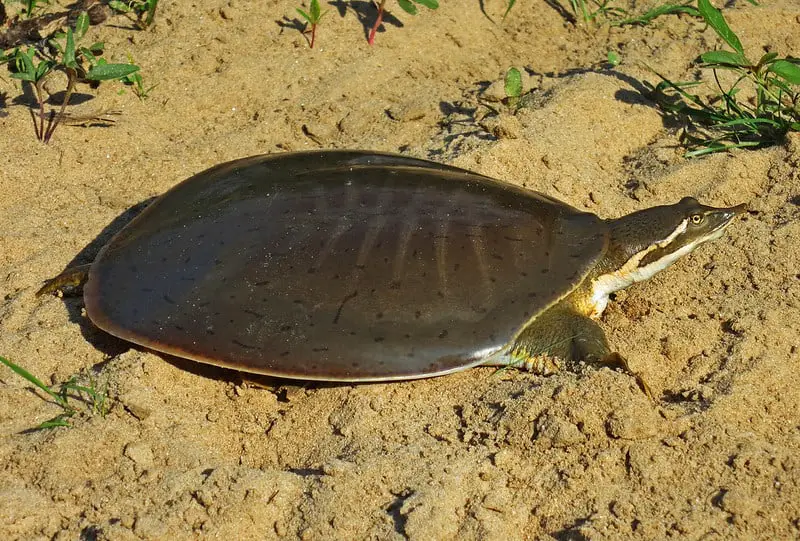
The turtle’s scientific name is Apalone mutica mutica. This is a subspecies of the smooth softshell species. As the name suggests, Midland smooth softshell is a softshell turtle with a soft and plain-looking shell. It has no distinct markings or patterns that distinguish it.
Their plastron is cream-colored, while the neck and the limbs have the same color as the shell. This turtle also has a thin, whitish, or greyish strip behind each of the eyes.
Midland smooth softshell grow relatively big with a mature turtle measuring between 6 and 13 inches long. They are common in water bodies that have soft mud or sandy bottoms. As for eating habits, they are omnivores but with a preference for meat over plants. This species will feed on flesh from small fish, snails, insects, and invertebrates. Occasionally, they do eat aquatic vegetation, fruits, and seeds.
Nesting occurs between May and July. Incubation lasts for about 70-100 days, and females only lay one clutch in a year carrying about 15 to 25 eggs. It takes sixty to a hundred days for the eggs to hatch.
Males mature sexually by the 4th year while females mature by the 9th year. Their lifespan is about 40 years in the wild, and they might be longer in captivity.
A juvenile Midland smooth softshell turtle costs between $30 and $50. You will require previous turtle skills to take care of this turtle successfully. Their main danger in the wild is flooding and predation during incubation. However, their populations are not threatened.
Ouachita Map Turtle
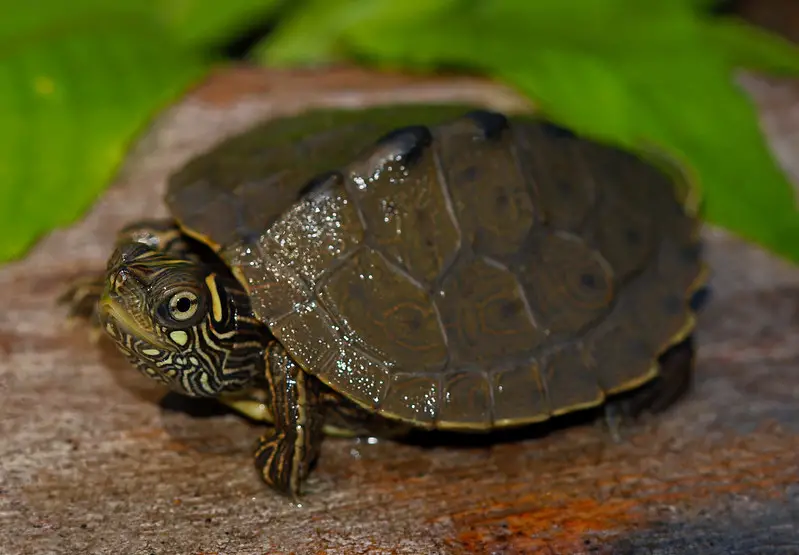
This is a subspecies of the map turtle species; their scientific name is Graptemys ouachitensis. It is unclear whether these turtles are Native in Ohio or were introduced illegally as pets because they are rare. In Ohio, Ouachita map turtles are only found in the lower banks of the Scioto River and near the mouth of the Great Miami River.
The shells of these turtles are either olive, brown, or black in color. Their carapace is keeled and has some patterns which fade as the turtle ages. Their plastron is usually yellow with few dark marks. The skin is covered in thin yellow and sometimes white lines.
When mature, these turtles will reach up to a maximum of 6.5 inches big in males and a maximum of 10 inches in females.
Ouachita map turtles are omnivores mostly feeding on meat, fruits, insects, vegetables, aquatic vegetation, and other available foods. Being aquatic, they are commonly found near slow-moving water bodies like lakes, rivers, streams, and ponds. They also prefer habitats with dense vegetation for cover and food. The lifespan of these Ohio map turtles is approximately 50 years.
Breeding occurs between April and September. The laying of eggs happens between April and July, while incubation is between late July and September. A female will lay between 10-12 eggs per clutch and may lay up to 3 clutches in a year.
Sexual maturity is achieved after the 14th year. A female nests just a few meters from its habitat, preferably on sandy soil.
Red-eared Slider
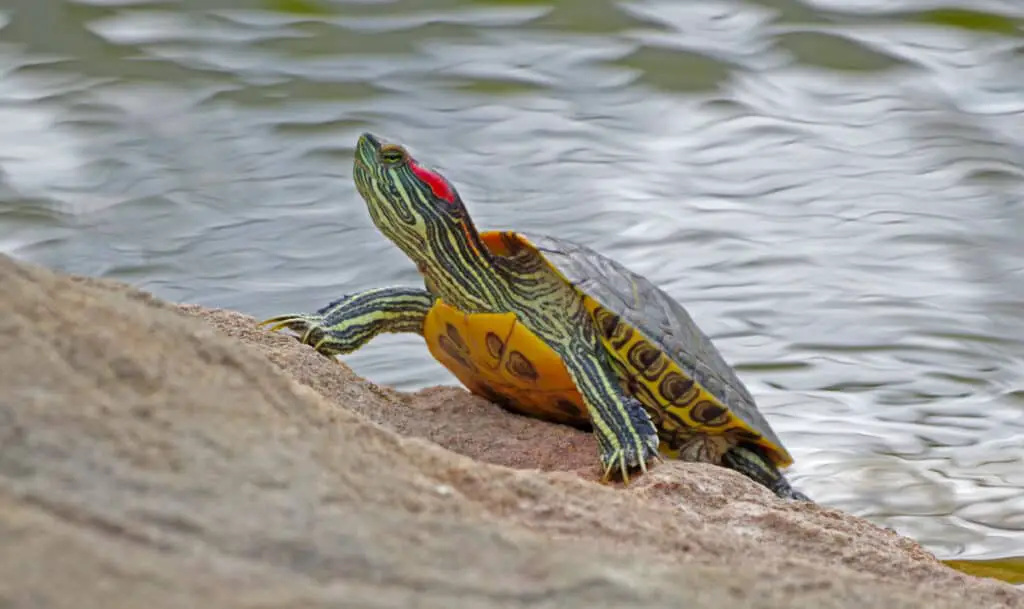
The scientific name for the sliders is Trachemys scripta elegans. They have a distinctive red or sometimes yellow stripe behind their ears. The upper part of its shell ranges from yellow to dark green or olive. In some turtles, it might also have some dark markings. The lower side is yellow or brown with dark patches.
Red-eared sliders are relatively large turtles that measure between 8 and 13 inches long. There are also recorded measurements of up to 15 inches. A distinct feature in males is that they have long claws and tails. They are also smaller than the females.
Sliders turtles are freshwater aquatic turtles commonly found in shallow, slow-moving water bodies like marshes, rivers, and streams. Further, they are also fond of basking on rocks when it is sunny. They will, however, jump quickly in the water when startled.
Red-eared slider turtles are omnivores whose diet consists of aquatic vegetation, fruits, seeds, insects, small fish, and invertebrates. They may venture out of the water to feed on the grass and other vegetation at times, but they never go far from their habitat. Their lifespan is between 30 and 50 years.
Sexual maturity in females is achieved by the 7th year or upon achieving 6 inches in carapace length. Males usually mature by the 5th year.
Their breeding starts from the month of April to September, when the eggs are hatched. A female will lay between 2, and 3 clutches a year, each holding between 4-15 eggs. Incubation in red-eared sliders is about 60 to 80 days.
A pet red-eared slider costs between $15 and $50. You will need some previous skills with turtles as they are sometimes aggressive and may cause injury to their owner. However, red-eared sliders are some of the most kept pet turtle species.
Wood Turtles
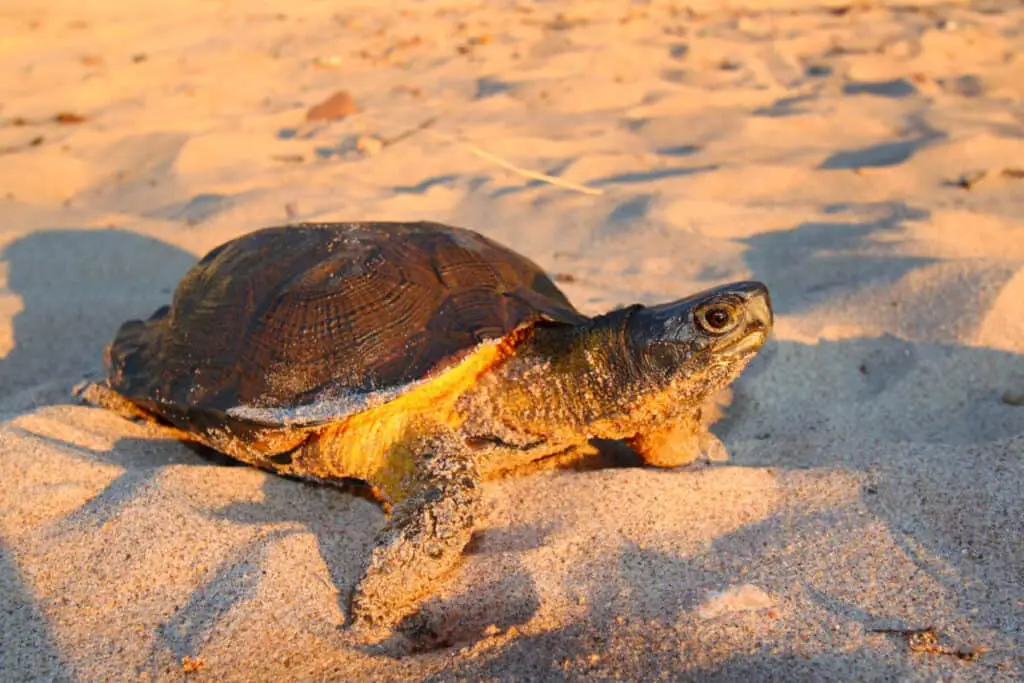
The scientific name for wood turtles is Glyptemys insculpta. It derives the term wood from the wood-like appearance of their shells in both the patterns and the texture.
Their shell has a more pronounced dome shape than in most other turtles and is also brown in color. The plastron is yellow with multiple dark spots. The skin is either orange or red with dark spots similar to the ones on the plastron.
Wood turtles can be said to be semi-aquatic but never venture very far from a water body. They are common in moderately flowing bodies with either soft mud or sandy bottoms.
These turtles are omnivores and feed mainly on wild berries, fruits, insects, aquatic vegetation, worms, and other aquatic animals. Food is the main reason why wood turtles go on land.
A female will achieve sexual maturity by the 18th year, while males take half that time. Nesting in wood turtles occurs between May and July. A female will lay between 3 and 20 eggs in a clutch and may lay up to 2 clutches every year. This is usually on the banks with loose sandy soil. The incubation will take about 80-100 days.
Woods turtles’ lifespan is between 45 and 55 years.
You will have to pay about $250 – $500 to acquire a wood turtle as a pet lover. You will also need previous skills dealing with turtles, as wood turtles may be pretty demanding.
Spotted Turtles
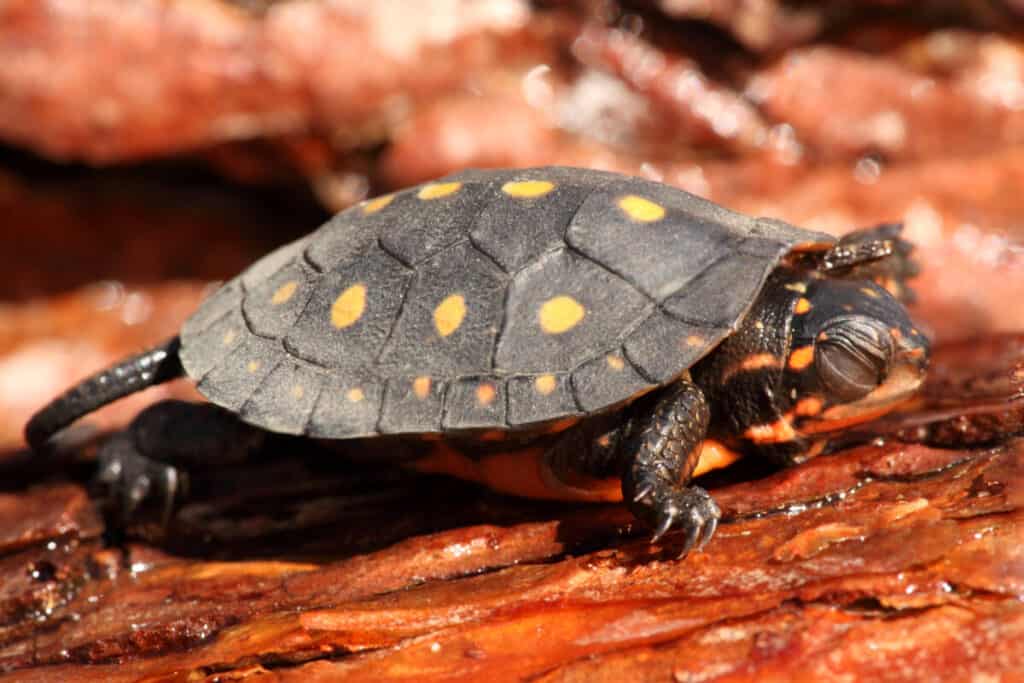
Clemmys guttata is the scientific name of a spotted turtle. They have a black upper shell that has either red or orange spots. The plastron is often either red, orange, or yellow with black patterns. Its skin’s lower part has a similar color as the plastron, while the upper part takes the color and pattern of the upper shell.
They are among the smallest turtles in the US, maturing at a meager 3 to 4 inches.
Spotted turtles, being aquatic, are common in marshes, swamps, wet meadows, shallow ponds, streams, and lakes. They are majorly omnivores, with their diet consisting of invertebrates, small aquatic animals and vegetation, and at times small fish. Spotted turtles spend most of their days in the water, only coming out to lay eggs, hibernate, and on rare occasions, to feed.
Spotted turtles begin their breeding season in May. Between May and July, a female spotted turtle will lay between 3-7 fertilized eggs per clutch. She only lays one clutch per year.
Incubation takes between 80 and 90 days. Hatchlings start emerging by the start of September. As with almost all other turtles, the sex of the hatchling depends on the warmth level in the incubation area. Warmer environments give females while colder ones give males.
Female spotted turtles take between 12 and 20 years to mature. Just like the box turtles, they are also able to store sperms in their bodies as they await conditions to improve. This greatly enhances the survival of their hatchlings.
Spotted turtles have a lifespan of about 100 years. They are considered an endangered species in Ohio.
Turtles Conservation Measures: How Can One Help Protect Turtles?
From the above in-depth look at the features of turtle species in Ohio, we can see that those turtles have been classified as endangered. If care is not taken, sadly, they might soon be all wiped out in Ohio.
While the state has her work cut out for her, individuals can also help ensure that our slow friends continue to be part of our ecosystem and in significant numbers. Here is how you can help:
Understand Your Turtles
One effective intervention through which you can help turtles is by understanding them. You cannot help them if you do not understand them. By learning the different turtle species and their distinct characteristics, you will know what to do.
For instance, should you find a turtle stranded in the wild and doesn’t belong there, you should call a vet officer to take them away. You should know that it is illegal in Ohio to take a turtle from the wild and keep it as a pet.
Report Poaching Activities
Poaching is one of the significant contributors to the declining populations of turtles in Ohio and the US in general. As a law-abiding citizen and a friend of turtles, it is your responsibility to ensure that you report any poaching activities to the Ohio Department of Natural Resources (ODNR).
Ohio has some exotic turtles in the pet market, for instance, Painted turtles, Red-eared sliders, Eastern musk, Blanding’s turtle, among others. They are at a worse risk of poaching compared to the other species.
Anyone who captures wild turtles and sells them is practicing poaching and should be reported to the authorities. Reporting such individuals will greatly hinder poaching and thus aid conservation measures.
Reporting Injured Turtles
Another good way you can assist in the conservation of turtles is by reporting the injured turtles. By reporting them to ODNR, the department will take the necessary steps to ensure that the turtles are well cared for. This may end up saving their lives.
Another way that can help is by bringing to the attention of the ODNR some issues that are affecting turtles in your region. For instance, a common occurrence is turtles being run over by vehicles when they are crossing the road. The department can take measures to ensure that the crossing areas are safer for the turtles.
Complying with the Rules Put in Place by ODNR
Some rules have been put in place by ODNR to safeguard the well-being of turtles. Simply following these rules and teaching others the importance of abiding by them will help conserve the turtle populations.
For instance, you can educate others that it is mandatory to have a license for some turtle species and that you shouldn’t keep a pet turtle from the wild.
Joining a Turtle Conservation Movement
As a follow-up to the above point, one of the best ways to influence the people in your surrounding is by joining a turtle conservation movement. Being in a movement enables you to learn more about turtles and also join efforts with like-minded people with a common goal.
A movement will also empower you to do more than you could ever achieve as an individual. Look for one in Ohio that is committed to supporting turtle conservation measures. Suppose you cannot find one. You may take up the challenge and start one yourself.
Conservation movements also educate people on common turtle breeding areas and urge people to avoid interference. In addition, they play a part in breeding hatchlings and releasing them to water bodies once ready.
Conclusion
There are 12 turtle species in Ohio, and we have had an in-depth look at their features and distinguishing characteristics. All of these species are either aquatic or semi-aquatic. Apart from the Spiny softshell turtles, the rest are all omnivores.
As we have seen, there are some endangered turtle species in Ohio. They include Blanding’s and spotted turtles. Their declining numbers are a significant threat to Ohio’s ecosystem because turtles play a significant part in the food web.
Since one of the major threats to turtles in Ohio is habitat destruction, it is vital to observe the set rules and regulations on turtles. You may find information on how best to aid in conserving turtle populations in Ohio. By educating yourself, you will know better and certainly, do better.
Learn more about other turtle species:
- Turtles In Oklahoma (17 Species Guide)
- Turtles In Maryland (Full Guide With Pictures)
- Turtles In Alabama (30 Species with Pictures)
- Kentucky Native Turtles (17 Species With Pictures)
- Indiana Native Turtles (Ultimate Guide With Pictures)
- Michigan Native Turtles (10 Species with Pictures)
- 18 Native Turtles in Tennessee (Guide With Pictures)
- Common Turtles Species in Massachusetts
- Turtles In South Carolina (20 Species With Pictures)
- Florida Turtles Guide (Full Guide With Pictures)